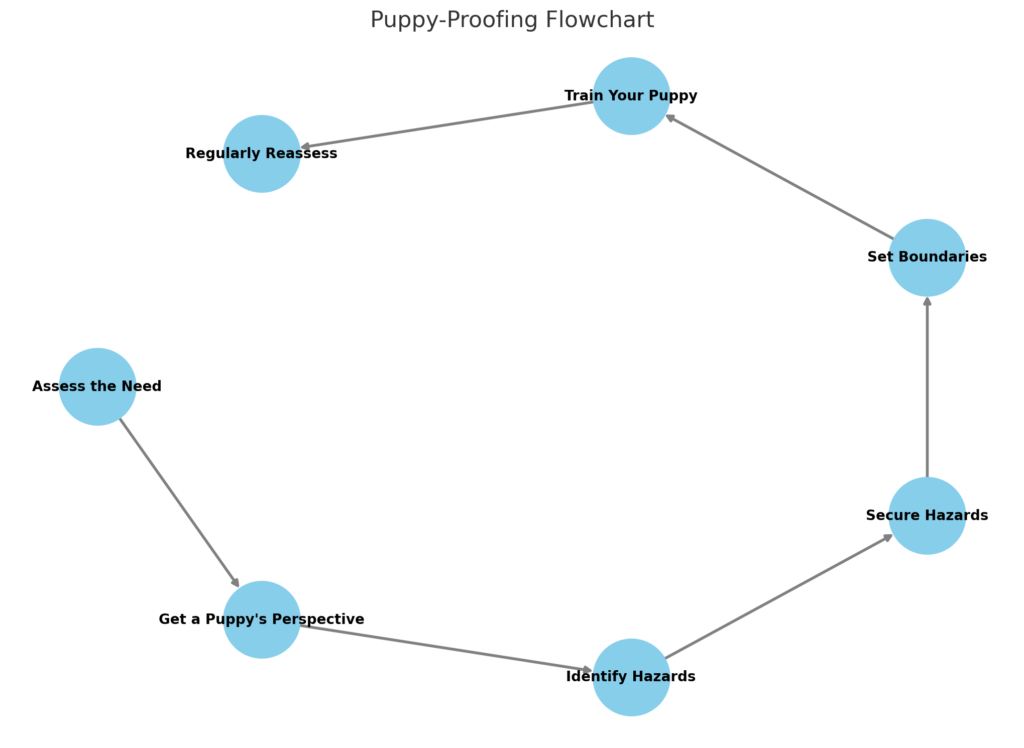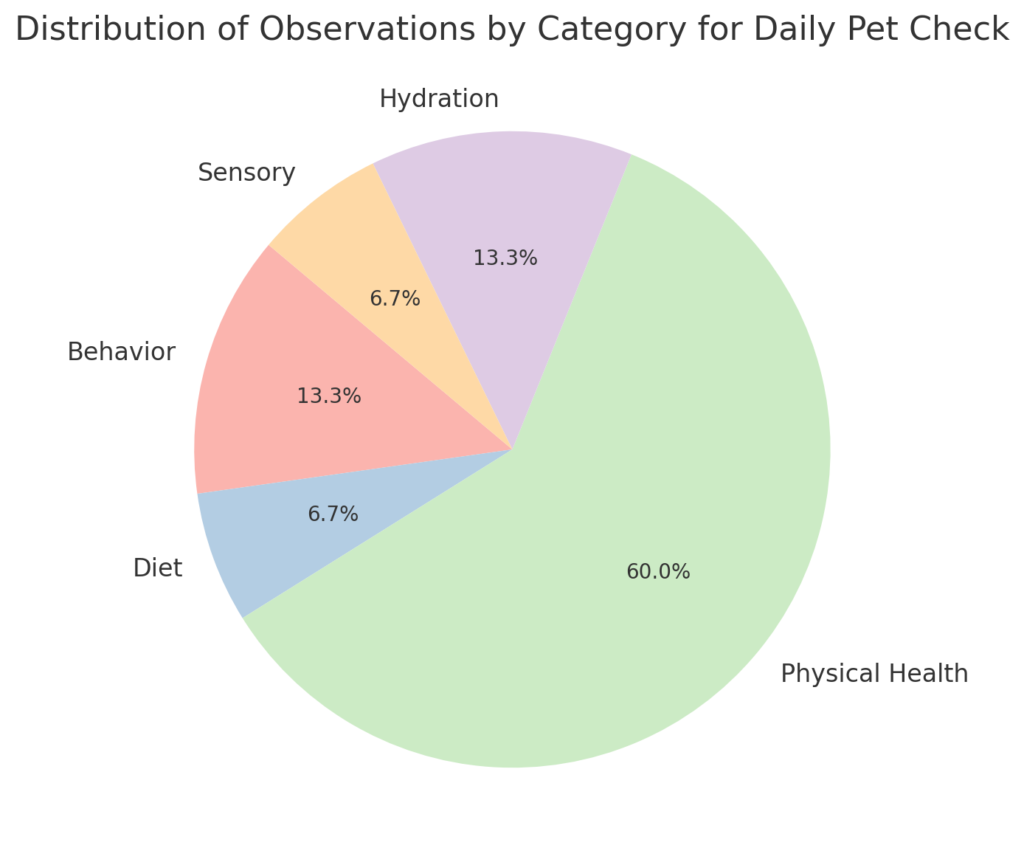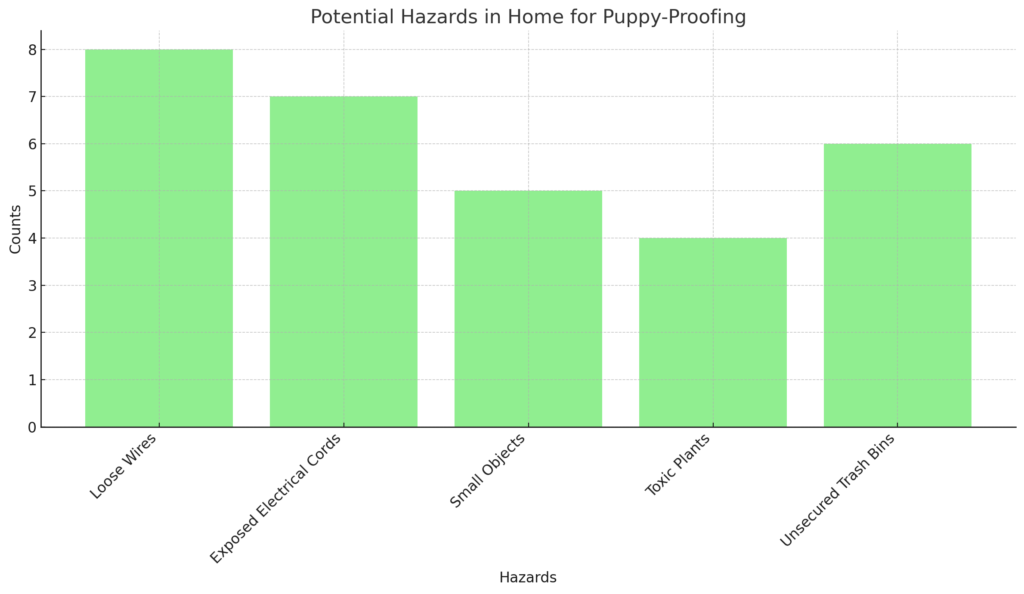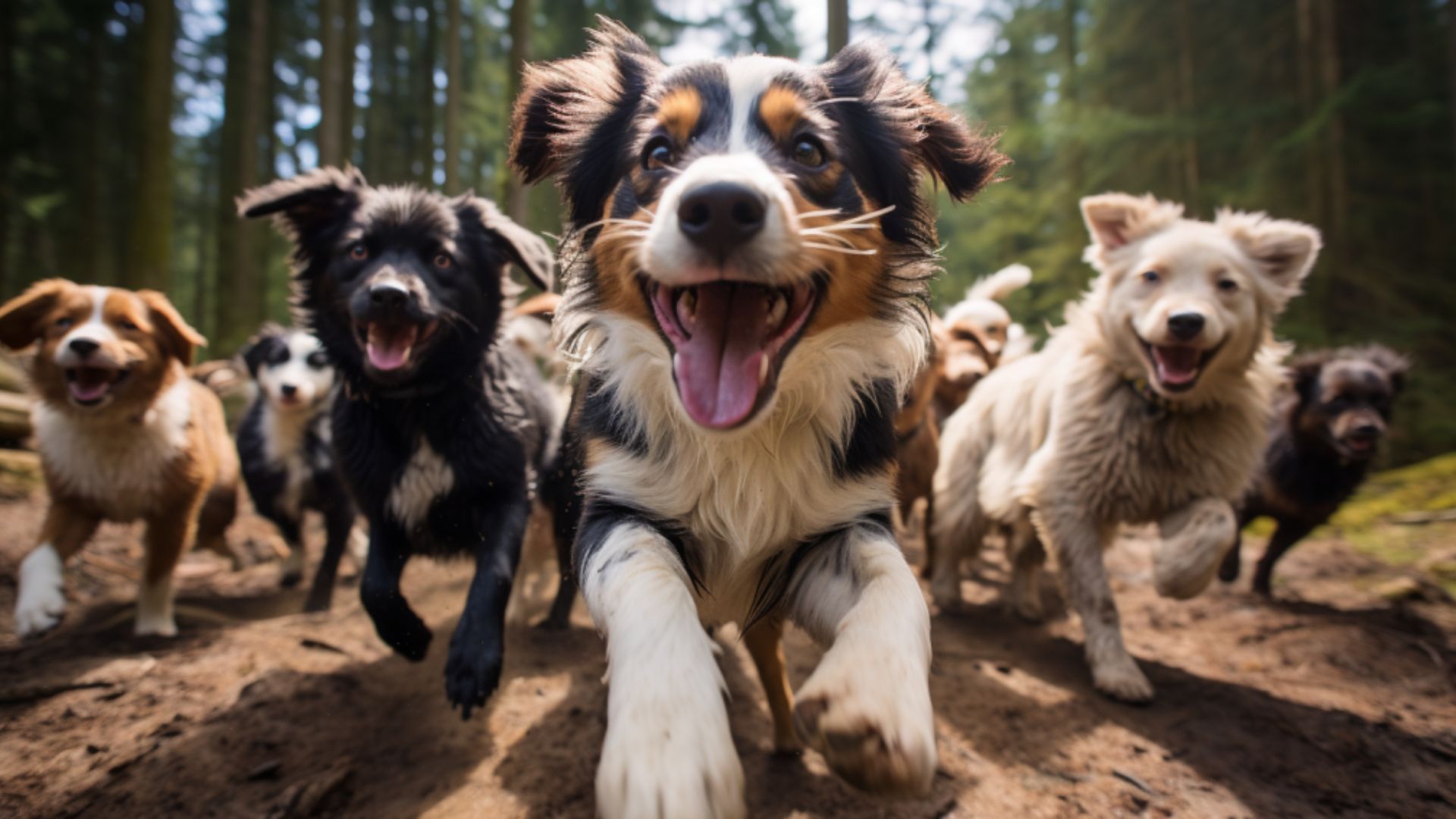Puppy Proofing Your Home: Transforming Spaces with Expert Advice
📍 Service Area Notice: DW Dog Training provides in-person training services exclusively in the Greater Baltimore area. While our blog content is designed to help dog owners internationally, our hands-on training services are locally focused. For readers outside our service area, we hope you find value in our articles and welcome you to reach out with questions!
Introduction to Puppy Proofing Your Home
Bringing a new puppy into your home is an exciting time! Your furry friend will bring you years of joy and companionship. However, those first few months with a rambunctious puppy require some additional preparation to keep them safe and your home intact. The process of removing dangers and setting boundaries in your house is known as puppy-proofing.
Puppy proofing is essential for any new dog owner. By taking the time to evaluate potential hazards from a puppy’s perspective, you can prevent destructive behavior, avoid costly repairs, and, most importantly – keep your pet from harm. The main goals of puppy proofing are:
- Promoting safety above all else
- Preventing damage to your possessions
- Setting reasonable boundaries indoors and out
To start, get down on your hands and knees and view each room from your puppy’s vantage point. Look for potential dangers within their reach that could pose a risk, such as loose electrical cords, poisonous houseplants, and choking hazards. Also, take note of tempting targets for chewing, like shoes, table legs, and cushions.
It helps to make a list of areas to puppy-proof as you assess your home. Here are some common spots to focus your efforts:
Puppy Proofing Priority Areas
| Area | Potential Dangers |
| Living Spaces | Electrical cords, houseplants, small objects, trash |
| Kitchen | Food scraps, chemicals, plastic bags |
| Bathroom | Toilet paper, medications, cleaning supplies |
| Bedrooms | Shoes, clothes, cords, bedding |
| Basement | Wires, storage containers, tools |
| Yard | Pesticides, toxic plants, gaps in fencing |
While it may seem daunting at first, puppy-proofing doesn’t have to be an overwhelming process. Take it one step at a time, tackling the most hazardous areas first. Removing dangers and establishing a safe, well-confined environment will give you peace of mind and help set your puppy up for success during this crucial training period.
Be sure to re-evaluate your home frequently as your puppy grows. As they gain size and independence, you may need to move breakable items to higher shelves, install sturdier pet gates, or cordon off previously accessible areas. A space that was properly puppy-proofed for a 2-month-old may need modifications for a teething 5-month-old!
Puppy proofing also extends to areas outside the home, especially if you have a yard or garden. We’ll cover specifics on prepping outdoor areas later in this guide. For now, start focusing your safety-proofing efforts inside the house.
While it takes a bit of time upfront, properly puppy-proofing your home will pay off exponentially in saving you from headaches down the road. Most importantly, it keeps your new furry companion safe. Setting your puppy up for success with a hazard-free environment full of appropriate chew toys will get your relationship off to the best possible start.
Key Takeaways on Puppy Proofing Your Home
- Evaluate your home from a puppy’s perspective to identify potential hazards within reach.
- Manage electrical dangers by securing cords, covering outlets, and blocking access.
- Eliminate choking risks by removing small objects and stowing harmful items.
- Set physical boundaries with gates, pens, and closed doors to restrict access.
- Keep enticing temptations like shoes and paper products out of reach.
- Anchor furniture and use pet-friendly materials to protect your belongings.
- Thoroughly inspect outdoor spaces for gaps, toxic plants, chemicals, and other hazards.
- Provide a safe, comfortable dedicated space for your puppy to call their own.
- Re-inspect and modify your puppy-proofing as your pet grows and develops new behaviors.
- Ask your veterinarian and puppy trainer for breed-specific proofing tips.
- Focus on removing dangers and establishing boundaries during the critical first few months at home.
- Proper puppy proofing takes diligence but gives peace of mind and keeps your pet safe.

Securing Potential Dangers
Puppies are naturally curious and tend to investigate their surroundings with their mouths. This can lead them to chew on and consume dangerous household items if left unsupervised. When puppy-proofing your home, be sure to secure the following potential hazards.
Managing Electrical Hazards
Puppies love to chew, and cords and wires are enticing targets. However, electrical dangers pose serious risks, including burns, electrical shock, or even electrocution. To puppy-proof your home’s electrical system:
- Use cord covers or cable wraps to conceal all loose cords from TVs, lamps, phone chargers, and holiday lights. Look for cord organizers that blend in with your decor.
- Install child safety locks on all unused outlets to prevent curious paws from investigating. Opt for low-profile, transparent options to maintain your wall’s aesthetic.
- Position furniture like bookcases, sofas, and desks to block access to outlets along the walls.
- Gather up extension cords when not in use rather than leaving them lying around.
Your goal is to limit access to electrical cords and outlets from all angles. Doing so will help avoid catastrophic electrical hazards. Pay special attention to kitchen and bathroom outlets near water sources.
Removing Choking Hazards
In addition to electrical dangers, puppy-proofing involves storing any small objects that could pose a choking hazard. Puppies explore new environments by putting items in their mouths, so keeping tempting targets like coins, marbles, batteries, and buttons safely secured prevents a trip to the emergency vet.
Potential choking dangers include:
- Coins, marbles, small balls
- Batteries, pins, needles, tacks
- Game pieces, small toys
- Plastic pieces from toys or packaging
- Twist ties, rubber bands
- Strings, thread spools
- Paper clips, push pins
Check under furniture and along baseboards for stray items. Look for gaps along chair or sofa cushions where small objects could fall. Store any choking hazards in securely latched cabinets or containers up and out of your puppy’s reach.
Containing the Environment
In addition to removing hazards, an important part of puppy-proofing involves setting physical boundaries to keep your pet safely contained. This allows you to restrict access to untrained areas while keeping a close eye on your pup.
Set Up Pet Gates and Pens
One of the best investments for puppy-proofing is quality pet gates. High enough to prevent jumping over, with openings small enough to prevent squeezing through, sturdy gates allow you to block off parts of your home.
Consider gating access to:
- Kitchen – Limit access to food prep areas and chemicals under sinks.
- Basement – Many basements contain hazards like exposed wiring, storage chemicals, or workout equipment.
- Cat zones – Keep the puppy away from litter boxes and food.
- Off-limit areas like formal living rooms until fully trained.
Expandable pet pens offer another useful tool for containing and supervising your puppy while keeping them safely confined. Use pens to create a designated potty area, an eat/sleep/play zone, or a contained area when you’re unable to actively supervise your pup.
Use Baby Gates and Door Barriers
For smaller zones of restriction, baby gates can be perfect for puppy-proofing. Mount them in doorways or hallways to quickly cordon off access. Pay attention to:
- Foot of stairs – block access to prevent tumbles.
- Kitchen doorway – limit entry when unattended.
- Bathrooms – keep your puppy away from toilet paper and chemicals.
- Master bedroom or nursery – prevent inappropriate chewing or accidents.
To deter door scratching, self-closing door barriers allow the door to swing shut while permitting pet access. These are great for areas like bathrooms and laundry rooms.
Strategic use of pens, gates, and barriers will allow your puppy access to safe zones while limiting destruction. Just be sure to watch for jumping or climbing over their boundaries!

Removing Temptations
In addition to obvious dangers, puppy proofing involves stowing tempting targets that could fall victim to curious puppy teeth or simply create a mess that requires cleaning up. Be proactive about removing these enticing items from your pup’s access.
Put Away Shoes, Clothes, Pillows
Puppies seem to find human shoes and clothing endlessly fascinating. Unfortunately, chewing on these items can destroy them and cause harm if pieces are swallowed. When puppy-proofing, place all footwear, slippers, socks, hats, and gloves into closets or onto high shelves.
Likewise, stow laundry bins, clean or dirty clothes piles, towels, and linens out of reach. Pillows and stuffed animals should be reserved for supervised playtimes. During initial puppy proofing, even dresser drawers and vanities may need to be shut until chewing tendencies subside.
Secure Trash and Paper Products
Puppies love shredding paper products and diving into trash cans for smelly treats. To be puppy-proof, use step cans or cans with locking lids. Place bathroom bins out of reach or inside cabinets.
Avoid leaving paper towels, tissues, toilet paper, or paper plates within reach on counters or end tables. Pups can quickly shred and consume paper, creating a major mess. Store paper goods sealed in cabinets until your puppy is fully trained.
Store Home Decor Out of Reach
The final category of temptation removal involves keeping away prized home decor pieces. This includes:
- Knickknacks and collectibles
- Houseplants and flower arrangements (ensure non-toxic)
- Books, magazines, mail, documents
- Remote controls, game controllers
- Holiday decorations and menorahs/candles
Place irreplaceable items into display cabinets or shelving units too high for little paws to investigate. Leave only pet-safe chew toys within your puppy’s access to encourage good behavior.
Furniture and Rugs
Puppies love to chew, and furniture legs or rug edges often catch their attention. Take steps to protect your belongings and your pet during the teething months.
Secure Shelves and Bookcases
Puppies may see curio cabinets, bookcases, and shelving units as vertical chew toys and attempt to gnaw on the lower edges. Top-heavy furniture can also be pulled down if used for leverage during play.
To puppy-proof these items, consider:
- Placing furniture anchors or anti-tip straps to secure tall bookcases and hutches to the wall.
- Applying bitter-tasting sprays on lower edges and table legs. Reapply frequently.
- Putting attractive tablecloths over the lower shelves to deter access.
- Storing prized collectibles or heirlooms up and out of reach until past the chewing phase.
Use Pet-Friendly Furnishings
For couches and armchairs, choose pet-friendly fabrics or covers to withstand puppy antics. Slipcovers can be removed and washed if needed.
Select a cozy dog bed and blanket to call their own. Provide designated chew toys to redirect any furniture chewing tendencies.
Choose Washable Rugs
Accidents happen during housetraining. Opt for indoor-outdoor area rugs constructed of durable, machine-washable materials rather than plush carpeting.
Natural fiber rugs like jute or seagrass make great choices. They’re textured like grass to attract pups yet able to withstand paws, accidents, and shaking off water after time outside.

Outdoor Areas
While much puppy-proofing focuses inside, don’t neglect safeguarding your outdoor spaces if you have a yard, deck, or garden. Puppies can get into trouble outside just as easily without proper preparation.
Inspect Fencing Thoroughly
Before allowing your puppy free reign of the yard, walk the perimeter and thoroughly check for:
- Gaps along the ground or under fencing that allow escape
- Loose boards or digging spots that provide openings
- Low points where a pup could jump or climb over
- Rusted wire or protruding edges that could harm
- Missing concrete at fence posts where digging occurs
Make necessary repairs to ensure your fencing is secure, stable, and puppy-proof. Supervise your pet each time they access the yard until you can trust their obedience.
Add Pool Fences and Gates
If you have an in-ground or above-ground pool, safety is imperative. Puppy-proof access by installing independent fencing or barriers around the entire perimeter. Self-latching gates prevent a pup from pushing through and gaining unsupervised entry.
When pool time is supervised, teach your puppy where the stairs or exit ramp are located. Introduce water slowly while providing praise and treats for overcoming hesitation. Never leave a puppy unsupervised around a pool.
Garden Care
Puppies use their mouths to explore, which often entails sampling plants, flowers, mulch, and dirt. Choose non-toxic varieties and avoid pesticides.
Research or ask your vet which flowers and vegetation pose risks if consumed. Remove or relocate toxic plants away from your puppy’s access.
Keep the grass trimmed and free of insect nests. Monitor for and control fleas, ticks, ants, and bees that could sting or bite an inquisitive pup. Consider fencing off newly planted or landscaped areas until established.
Ongoing Precautions
Puppy-proofing your home is an essential first step, but don’t consider it a one-and-done process. Maintaining safety requires ongoing diligence as your puppy develops.
- Supervise your puppy closely when they are not crated or contained in a pen. Puppies get into trouble quickly, so keep them in view at all times during the first few months at home.
- As your puppy grows, reevaluate size restrictions. For example, a barrier that contained a 2-month-old may need to be heightened to prevent an agile 5-month-old from jumping over.
- Reinspect puppy proofing periodically and make changes based on new behaviors. Puppies go through phases of development, so continue assessing potential hazards.
- Pay attention to new destructive or ingestion tendencies and respond by removing those items. Sometimes, setbacks occur during teething or rebellious phases.
- If you observe your puppy accessing an area you want to restrict access to, take action. Close doors, install gates, or use furniture to block entry points.
- Tell house guests how to interact with your puppy and keep them from inadvertently letting the pet into off-limit areas or feeding unhealthy treats. Ask them to help puppy-proof by keeping doors closed and items picked up.
- When leaving your home, double-check that you’ve contained your puppy in a crate or pen with proper supervision. Don’t assume they will remain where you left them.
- Remain alert and don’t stop actively puppy-proofing until your dog matures past the chewing, teething, and destructive phases – usually between 10-14 months old.
Proper precautions require work, but avoiding a single tragedy is worth the diligence and attention. Stay alert and be consistent, even when your puppy seems “fully trained.” Accidents can still happen.
Prepare a Safe Space
An important component of puppy proofing is designating a secure, comfortable area your pet can call their own. This space should meet your puppy’s needs for safety, sleep, and play.
For many pet owners, a pet crate serves this purpose. The right crate becomes a den-like retreat that helps a puppy feel relaxed and settled when you’re unable to supervise them actively.
Look for crates designed for growing puppies that allow ample room to stand, turn around, and lie down. Place a washable plush mat or bed inside, along with fresh water. The crate should be just large enough for necessities to prevent potty accidents.
You can also designate a puppy-friendly room or exercise pen as your pet’s personal quarters. Childproof the area fully and include:
- Designated potty space, if not yet housetrained
- Food and water bowls
- Comfortable bed
- Variety of chew toys
- Play activities like tunnels, slow feeders, lick mats
Rotate special treats and chews to keep their area exciting. Try frozen stuffed Kongs, bully sticks, and rubber puzzle toys. Avoid leaving rawhides or edibles when unsupervised.
The space should be a place your puppy enjoys spending time in. Feed meals there and incorporate high-value reward training sessions. Make it fun and stimulating through rotations of toys, scents, and snacks.
This dedicated puppy zone serves multiple purposes: confinement when you can’t supervise directly, sleeping area at night, and a play/training space for bonding. Properly preparing this safe zone is a key aspect of puppy-proofing your home.
Resources for Puppy Proofing
Now that you know what’s involved with puppy-proofing, here are some useful resources to make the process easier:
Recommended Products
- Pet gates – Choose adjustable, freestanding gates from brands like Frisco or Carlson for safety and durability. Look for small openings to avoid escapes.
- Playpens – IRIS exercise pens provide ample room yet easy portability.
- Crate mats – Frisco cooling crate mats or American Kennel Club crate pads add comfort.
- Chew deterrents – Grannick’s Bitter Apple Spray stops furniture chewing.
- Cabinet locks – Safety 1st child proof latches keep kitchen cabinets secured.
- Cord organizers – Cordsmith cord covers neatly contain electrical hazards.
- Furniture anchors – Quakehold Museum putty safely secures moveable items.
Where to Buy
Big box stores like PetSmart, PetCo, and Pet Supplies Plus carry a variety of puppy-proofing tools. You can also find quality supplies online:
- Chewy.com offers low prices and fast shipping on pet essentials.
- Amazon.com allows easy price comparisons on dog supplies.
- Home Depot, Lowes, and hardware stores supply child safety products suitable for pet-proofing.
Ask Your Vet
Consult with your veterinarian for personalized advice on puppy-proofing your breed. They can advise on specific risks related to your puppy’s age, size, and tendencies.
Come armed with a list of concerns and questions. Ask about proper housetraining techniques, crate training duration, exercise limits, and developmental milestones so you can properly puppy-proof during each stage.
Ask Your Puppy Trainer
Your professional puppy trainer can provide personalized advice on effectively puppy-proofing your specific home and breed. Explain your concerns and layout, and ask for recommendations on high-risk areas to safeguard.
Trainers know the developmental stages puppies go through and can identify potential hazards you may overlook. Take notes during training sessions on areas your puppy is curious about or attempting to access so you can be better puppy-proof.
Final Thoughts
Bringing a new puppy home is an exciting adventure! While you look forward to fun times ahead, making sure your home is properly puppy-proofed ensures your new family member’s safety and protects your belongings.
By taking the time to evaluate your environment from a puppy’s perspective, you can identify and eliminate dangers that could cause harm. Careful preparation also prevents destructive chewing behaviors from developing in those impressionable early months.
Puppy-proofing your space completely takes diligence. Prioritize hazardous areas like kitchens and bathrooms first, then tackle the full house room-by-room. Look for opportunities to set boundaries using gates and pens while removing access to tempting and unsafe items.
The initial time investment pays off exponentially in peace of mind, knowing your home is secure. Re-inspecting periodically and staying vigilant will keep your puppy protected as they grow and develop independence.
While no process can be 100% foolproof, your commitment to puppy-proofing demonstrates responsible pet parenting. Providing a safe environment set up for success allows your puppy to blossom into a happy, well-adjusted dog.
Most importantly, proper puppy-proofing saves you from stress and expensive fixes down the road. Starting out on the right paw with your furry friend leads to a lifetime of loyal companionship. They’re counting on you to keep them safe during these formative months.
We cover puppy-proofing essentials in this guide, but don’t hesitate to seek professional help. Your veterinarian and a certified puppy trainer can provide breed-specific proofing tips. Here’s to many wonderful years together with a puppy-proofed home and a healthy, well-trained pet! Stay vigilant, be patient, and enjoy all the puppy love headed your way.

